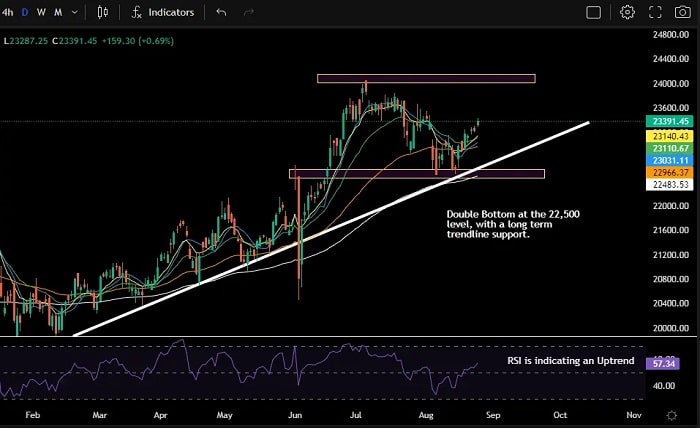
Introduction
For financial traders, understanding market movements is key to success, and the Finnifty live chart is an essential tool in the world of stock market indices. Finnifty, or the Nifty Financial Services Index, represents the financial sector’s performance in the Indian stock market, focusing on banking, insurance, and financial services. Monitoring the Finnifty live chart gives traders real-time insights into the index’s performance, helping them make timely trading decisions. In this guide, we’ll delve into what the Finnifty live chart is, how it works, and why it’s vital for both novice and experienced traders.
What is Finnifty?
Before diving into the Finnifty live chart, it’s important to understand what Finnifty is. Finnifty is an index that tracks the performance of 20 of the largest financial sector stocks listed on the National Stock Exchange (NSE) in India. These include major banks, financial institutions, and insurance companies. The index is a critical indicator of the financial sector’s health and performance, making the Finnifty live chart a go-to tool for investors focused on this sector. By observing the Finnifty live chart, traders can keep an eye on the sector’s overall trends and individual stock performance within the index.
Discover the perfect gifts for him, from stylish accessories to unique experiences that he’ll cherish and enjoy.
How to Access the Finnifty Live Chart
Accessing the Finnifty live chart is straightforward, thanks to numerous financial platforms offering real-time data. Websites such as NSE India, investing.com, and various stock trading apps provide live streaming of the Finnifty chart. These platforms display the Finnifty live chart with various time frames, such as intraday, daily, weekly, or monthly views, helping traders analyze the data over different periods. Additionally, financial terminals like Bloomberg and Reuters offer advanced versions of the Finnifty live chart, equipped with detailed indicators and analysis tools.
Reading the Finnifty Live Chart
Interpreting the Finnifty live chart involves understanding its key components: price movements, volume data, and time frames. The chart represents the real-time fluctuations of the Finnifty index based on market conditions. The X-axis of the Finnifty live chart shows time, while the Y-axis displays the index value. Traders can view changes in the Finnifty value over specific periods, which helps them identify market trends, resistance levels, and support zones. Mastering how to read the Finnifty live chart is crucial for making informed decisions in a fast-moving market.
Key Indicators to Use with the Finnifty Live Chart
When using the finnifty live chart, traders often rely on key technical indicators to enhance their analysis. Some of the most commonly used indicators include moving averages, Bollinger Bands, the Relative Strength Index (RSI), and MACD (Moving Average Convergence Divergence). These indicators help traders identify trends, momentum, and possible reversal points on the Finnifty live chart. For example, moving averages provide insights into the index’s direction over a certain period, while RSI helps determine whether the market is overbought or oversold.
Importance of Real-Time Data in Finnifty Live Chart
The significance of the Finnifty live chart lies in its ability to provide real-time data. For traders, real-time updates are crucial because market conditions can change rapidly, and any delay in accessing this information can lead to missed opportunities. The Finnifty live chart gives investors the advantage of tracking minute-by-minute price movements, ensuring that they can react quickly to changes. Whether you’re a day trader or a long-term investor, having access to the Finnifty live chart ensures you stay ahead of market fluctuations and make timely trading decisions.
Finnifty Live Chart vs. Other Indices
Many traders wonder how the Finnifty live chart compares to other indices like the Nifty 50 or Bank Nifty. While the Nifty 50 covers a broad spectrum of the Indian stock market, the Finnifty live chart focuses specifically on the financial sector, making it ideal for traders interested in financial services, banking, and insurance stocks. In contrast, Bank Nifty is more focused on the banking segment alone. The Finnifty live chart provides a broader view of the entire financial services sector, offering more comprehensive insights into this industry’s performance.
Strategies for Trading with Finnifty Live Chart
Effective trading using the Finnifty live chart requires developing well-thought-out strategies. One common strategy is trend-following, where traders use the Finnifty live chart to identify ongoing trends and trade in the direction of the trend. Another popular strategy is range trading, where traders identify resistance and support levels on the Finnifty live chart and place trades accordingly. Additionally, using indicators such as the RSI and Bollinger Bands on the Finnifty live chart can help traders spot potential breakout or reversal points, allowing them to optimize their entry and exit points.
Risks and Considerations When Using Finnifty Live Chart
While the Finnifty live chart is an invaluable tool, it’s important to acknowledge the risks associated with trading based on real-time data. Markets can be volatile, and relying solely on the Finnifty live chart without considering external factors, such as economic events, company announcements, or global market trends, can be risky. It’s essential for traders to combine technical analysis from the Finnifty live chart with fundamental analysis to ensure they make informed decisions. Additionally, risk management tools like stop-loss orders are crucial when trading with the Finnifty live chart to protect against significant losses.
How to Use the Finnifty Live Chart for Long-Term Investments
While many traders use the Finnifty live chart for short-term trading, it’s also a valuable tool for long-term investors. Long-term investors can use the Finnifty live chart to identify macro trends in the financial sector and make investment decisions based on broader market movements. By analyzing the Finnifty live chart over extended time frames, investors can spot cyclical trends, evaluate the overall health of the financial sector, and assess the long-term performance of companies within the index. This helps investors build a more resilient portfolio aligned with the financial sector’s growth prospects.
Conclusion
The Finnifty live chart is an essential tool for traders and investors looking to engage with the financial sector in real time. It offers a wealth of information, from price movements and volume data to key technical indicators, making it an invaluable resource for analyzing market trends and making informed trading decisions. By learning how to read and interpret the Finnifty live chart effectively, traders can gain a competitive edge in the market. Whether you’re a short-term trader looking for quick opportunities or a long-term investor seeking to understand broader financial trends, the Finnifty live chart provides the insights you need to navigate the complexities of the stock market.
FAQs
1. What is Finnifty, and how does it differ from Nifty?
Finnifty represents the financial services sector, tracking the performance of 20 key financial stocks, whereas Nifty tracks the broader market with 50 top companies across various sectors. The Finnifty live chart focuses specifically on the financial services industry, making it ideal for traders interested in this sector.
2. How can I access the Finnifty live chart?
You can access the Finnifty live chart on platforms like the NSE India website, investing.com, and various stock trading apps. Financial terminals such as Bloomberg and Reuters also provide advanced versions of the Finnifty live chart with real-time data and additional analysis tools.
3. What are the key indicators to use with the Finnifty live chart?
Common indicators used with the Finnifty live chart include moving averages, RSI, Bollinger Bands, and MACD. These indicators help traders analyze trends, momentum, and potential reversal points to make informed trading decisions.
4. Can the Finnifty live chart be used for long-term investments?
Yes, the Finnifty live chart is valuable for long-term investors as well. By analyzing the chart over extended time frames, investors can identify macro trends in the financial sector, allowing them to make informed decisions about long-term investments in financial stocks.
5. What are the risks of relying solely on the Finnifty live chart?
While the Finnifty live chart provides real-time data, relying solely on it without considering external factors, such as economic news or global market conditions, can be risky. Traders should combine technical analysis with fundamental analysis and use risk management tools like stop-loss orders to minimize potential losses.




